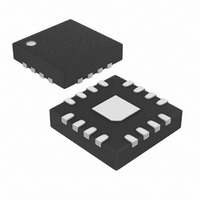MAX9759ETE+ Maxim Integrated Products, MAX9759ETE+ Datasheet - Page 10

MAX9759ETE+
Manufacturer Part Number
MAX9759ETE+
Description
IC AMP AUDIO PWR 3.2W D 16TQFN
Manufacturer
Maxim Integrated Products
Type
Class Dr
Datasheet
1.MAX9759ETE.pdf
(20 pages)
Specifications of MAX9759ETE+
Output Type
1-Channel (Mono)
Max Output Power X Channels @ Load
4.3W x 1 @ 3 Ohm
Voltage - Supply
3 V ~ 5.5 V
Features
Depop, Differential Inputs, Mute, Short-Circuit and Thermal Protection, Shutdown
Mounting Type
Surface Mount
Package / Case
16-TQFN Exposed Pad
Product
Class-D
Output Power
3.2 W
Common Mode Rejection Ratio (min)
67 dB
Thd Plus Noise
0.03 %
Operating Supply Voltage
3 V to 5.5 V
Supply Current
8.4 mA
Maximum Power Dissipation
1.8 W
Maximum Operating Temperature
+ 85 C
Mounting Style
SMD/SMT
Minimum Operating Temperature
- 40 C
Supply Voltage (max)
5.5 V
Supply Voltage (min)
3 V
Amplifier Class
D
No. Of Channels
1
Supply Voltage Range
3V To 5.5V
Load Impedance
4ohm
Operating Temperature Range
-40°C To +85°C
Amplifier Case Style
TQFN
Rohs Compliant
Yes
Lead Free Status / RoHS Status
Lead free / RoHS Compliant
3.2W, High-Efficiency, Low-EMI,
Filterless, Class D Audio Amplifier
The MAX9759 filterless, Class D audio power amplifier
features several improvements to switch-mode amplifier
technology. The MAX9759 offers Class AB performance
with Class D efficiency, while occupying minimal board
space. A unique modulation scheme, synchronizable
switching frequency, and SSM mode create a compact,
flexible, low-noise, efficient audio power amplifier. The
differential input architecture reduces common-mode
noise pickup, and can be used without input-coupling
capacitors. The device can also be configured as a sin-
gle-ended input amplifier.
Comparators monitor the MAX9759 inputs and com-
pare the complementary input voltages to the sawtooth
waveform. The comparators trip when the input magni-
tude of the sawtooth exceeds their corresponding input
voltage. Both comparators reset at a fixed time after the
rising edge of the second comparator trip point, gener-
10
6, 14
9, 12
______________________________________________________________________________________
PIN
10
11
13
15
16
EP
1
2
3
4
5
7
8
SYNC_OUT
NAME
SHDN
PGND
SYNC
MUTE
OUT+
PV
OUT-
GND
V
IN+
IN-
G2
G1
EP
DD
DD
Detailed Description
Analog Power Supply. Bypass to GND with a 1µF ceramic capacitor.
Noninverting Audio Input
Inverting Audio Input
Analog Ground
Active-Low Shutdown Input. Drive SHDN low to shut down the MAX9759. Connect to V
operation.
Power Ground
Frequency Select and External Clock Input:
SYNC = GND: Fixed-frequency mode with f
SYNC = FLOAT: Fixed-frequency mode with f
SYNC = V
SYNC = Clocked: Fixed-frequency mode with f
Active-Low Mute Function. Drive MUTE low to disable the H-bridge outputs. Connect to V
normal operation.
H-Bridge Power Supply. Bypass to PGND with a 10µF ceramic capacitor.
Negative Speaker Output
Positive Speaker Output
Internal Clock Output. Connect SYNC_OUT to the clock input of cascaded Maxim Class D
amplifiers. Float SYNC_OUT if unused.
Gain Control 2 (See Table 2)
Gain Control 1 (See Table 2)
Exposed Paddle. Can be left floating or tied to GND. For optimum thermal performance, connect EP
to GND.
Operating Modes
DD
: Spread-spectrum mode with f
ating a minimum-width pulse t
the second comparator (Figure 1). As the input voltage
increases or decreases, the duration of the pulse at
one output increases (the first comparator to trip) while
the other output pulse duration remains at t
This causes the net voltage across the speaker (V
- V
The MAX9759 features two FFM modes. The FFM
modes are selected by setting SYNC = GND for a
1.1MHz switching frequency, and SYNC = FLOAT for a
1.5MHz switching frequency. In FFM mode, the fre-
quency spectrum of the Class D output consists of the
fundamental switching frequency and its associated
harmonics (see the Wideband Output Spectrum (FFM
Mode) graph in the Typical Operating Characteristics).
The MAX9759 allows the switching frequency to be
changed, should the frequency of one or more of the
harmonics fall in a sensitive band. This can be done at
any time and does not affect audio reproduction.
OUT-
S
S
FUNCTION
= 1100kHz.
S
= 1200kHz ±70kHz.
) to change.
S
= 1500kHz.
= external clock frequency.
Fixed-Frequency Modulation (FFM) Mode
ON(MIN)
Pin Description
at the output of
DD
DD
for normal
ON(MIN)
for
OUT+
.












